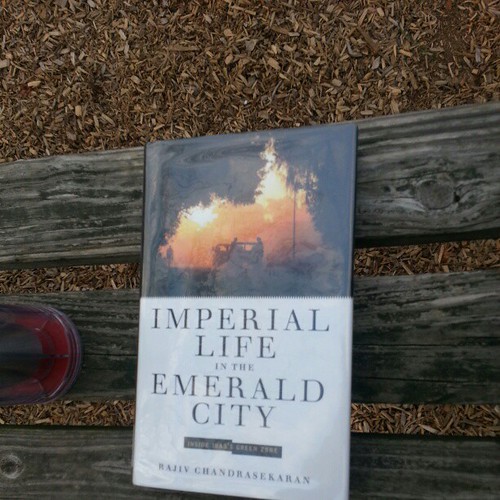Yesterday I got a chance to spend some down time at the library and picked a few iraq war themed books. The book Imperial Life in the Emerald City: Inside Iraq's Green Zone [DECKLE EDGE] (Hardcover) published in 2006 had been on my mind for a long time. I admired Washington Post's Rajeev Chandrasekaran and his coverage of the wars in Afghanistan and Iraq. From the book it would seem that the reconstruction of IRAQ could have been planned safely in the US rather than in Baghdad as it was virtually isolated from the reality of Baghdad. The split in the Bush cabinet and its effect on this war is evident. The Army comes out good here as they were in the forefront and mingled with the citizens of IRAQ. A doctorine that may have salvaged the US efforts in the period after Rajiv's book.
published in 2006 had been on my mind for a long time. I admired Washington Post's Rajeev Chandrasekaran and his coverage of the wars in Afghanistan and Iraq. From the book it would seem that the reconstruction of IRAQ could have been planned safely in the US rather than in Baghdad as it was virtually isolated from the reality of Baghdad. The split in the Bush cabinet and its effect on this war is evident. The Army comes out good here as they were in the forefront and mingled with the citizens of IRAQ. A doctorine that may have salvaged the US efforts in the period after Rajiv's book.

Imperial Life in the Emerald City: Inside Iraq's Green Zone [DECKLE EDGE] (Hardcover)
After reading the book I feel like a lot of is in America have watched the war with the eye of a indifferent bystander. Rajiv points to the mistakes that were made during the "reconstruction", not preparing for what would happen after the war was won. I always assumed that we had a great number of folks war gaming difference scenarios. From the book it seems the US had asked the Iraqis to stay home and after the hostilities ended they were waiting for a call back which never happened and the looters took advantage of this.
See this part of the book - courtesy of Google Books
I can't wait to read Rajiv Chandrasekar's second book Little America: The War Within the War for Afghanistan
Reading the book also intrigued me and I will try to watch this movie Green Zone .
.
Here is a great slideshow on Flickr "Minister of Goodwill" with pictures of the Green Zone and other scenes that you can associate with the book

Imperial Life in the Emerald City: Inside Iraq's Green Zone [DECKLE EDGE] (Hardcover)
After reading the book I feel like a lot of is in America have watched the war with the eye of a indifferent bystander. Rajiv points to the mistakes that were made during the "reconstruction", not preparing for what would happen after the war was won. I always assumed that we had a great number of folks war gaming difference scenarios. From the book it seems the US had asked the Iraqis to stay home and after the hostilities ended they were waiting for a call back which never happened and the looters took advantage of this.
See this part of the book - courtesy of Google Books
I can't wait to read Rajiv Chandrasekar's second book Little America: The War Within the War for Afghanistan
Reading the book also intrigued me and I will try to watch this movie Green Zone
Here is a great slideshow on Flickr "Minister of Goodwill" with pictures of the Green Zone and other scenes that you can associate with the book
Comments